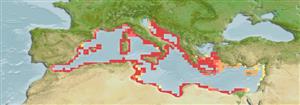>
Eupercaria/misc (Various families in series Eupercaria) >
Labridae (Wrasses)
Etymology: Centrolabrus: Greek, kentron = sting + Greek, labros = furious (Ref. 45335).
More on author: Risso.
Environment: milieu / climate zone / depth range / distribution range
Écologie
marin récifal; profondeur 1 - 25 m (Ref. 4742). Subtropical; 46°N - 30°N, 6°W - 36°E
Mediterranean Sea: including the Sea of Marmara.
Taille / Poids / Âge
Maturity: Lm ? range ? - ? cm
Max length : 14.0 cm TL mâle / non sexé; (Ref. 4742); common length : 11.0 cm TL mâle / non sexé; (Ref. 4742)
Adults are found in the littoral zone, in rocky areas and seagrass beds. Act as "cleaners". Feed on worms, small amphipods, copepods, bryozoans and hydrozoans (Ref. 4742). Males keep watch over Cystoseria-covered spawning territory though no nesting is done (Ref. 4742). Oviparous, distinct pairing during breeding (Ref. 205). Males build dish shaped nests and guard the eggs (Ref. 205).
Life cycle and mating behavior
Maturities | Reproduction | Spawnings | Egg(s) | Fecundities | Larves
Oviparous, distinct pairing during breeding (Ref. 205). Males build dish shaped nests and guard the eggs (Ref. 205).
Quignard, J.-P. and A. Pras, 1986. Labridae. p. 919-942. In P.J.P. Whitehead, M.-L. Bauchot, J.-C. Hureau, J. Nielsen and E. Tortonese (eds.) Fishes of the north-eastern Atlantic and the Mediterranean. UNESCO, Paris. Vol. 2. (Ref. 4742)
Statut dans la liste rouge de l'IUCN (Ref. 130435)
Menace pour l'homme
Harmless
Utilisations par l'homme
Outils
Articles particuliers
Télécharger en XML
Sources Internet
Estimates based on models
Preferred temperature (Ref.
123201): 17.6 - 21.8, mean 19.3 °C (based on 481 cells).
Phylogenetic diversity index (Ref.
82804): PD
50 = 0.7500 [Uniqueness, from 0.5 = low to 2.0 = high].
Bayesian length-weight: a=0.01000 (0.00623 - 0.01606), b=3.04 (2.90 - 3.18), in cm total length, based on LWR estimates for this species & (Sub)family-body (Ref.
93245).
Niveau trophique (Ref.
69278): 3.2 ±0.1 se; based on diet studies.
Résilience (Ref.
120179): Haut, temps minimum de doublement de population inférieur à 15 mois (Preliminary K or Fecundity.).
Fishing Vulnerability (Ref.
59153): Low vulnerability (10 of 100).
Nutrients (Ref.
124155): Calcium = 60.9 [26.9, 127.7] mg/100g; Iron = 0.761 [0.406, 1.555] mg/100g; Protein = 19.1 [16.2, 21.3] %; Omega3 = 0.23 [0.13, 0.41] g/100g; Selenium = 10.5 [5.0, 22.0] μg/100g; VitaminA = 85.7 [24.2, 370.8] μg/100g; Zinc = 1.24 [0.77, 2.20] mg/100g (wet weight);
